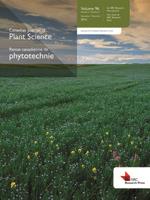Whalen, J. K., Gul, S., Poirier, V., Yanni, S. F., Simpson, M. J., Clemente, J. S., Feng, X., Grayston, S. J., Barker, J., Gregorich, E. G., Angers, D. A., Rochette, P. and Janzen, H. H. 2014. Transforming plant carbon into soil carbon: Process-level controls on carbon sequestration. Can. J. Plant Sci. 94: 1065-1073. Plants figure prominently in efforts to promote C sequestration in agricultural soils, and to mitigate greenhouse gas (GHG) emissions. The objective of the project was to measure the transformations of plant carbon in soil through controlled laboratory experiments, to further understand (1) root-associated CO2 and N2O production during a plant's life cycle, (2) decomposition of plant residues leading to CO2 production, and (3) stabilization and retention of undecomposed plant residues and microbial by-products in the resistant soil C fraction. Experimental plant materials included transgenic near isolines of Zea mays L. and cell wall mutants of Arabidopsis thaliana, selected for their diverse residue chemistry. Phenology, morphology and above-ground biomass affected soil respiration and N2O production in root-associated soils. Mineralization of C and N from incubated plant-soil mixtures was complemented with stable isotope tracing (13C, 15N) and 13C-phospholipid fatty acid analysis. Advanced chemical techniques such as nuclear magnetic resonance spectroscopy and physical separation (particle size and density separation) were used to track the transformations of plant C into stable soil C compounds. Conceptual models were proposed to explain how the plant residue chemistry×soil physico-chemical interaction affects C sequestration. Incorporating single gene mutations affecting lignin biosynthesis into agricultural and bioenergy crops has the potential to alter short- and long-term C cycling in agroecosystems.
How to translate text using browser tools
27 October 2013
Transforming plant carbon into soil carbon: Process-level controls on carbon sequestration
Joann K. Whalen,
Shamim Gul,
Vincent Poirier,
Sandra F. Yanni,
Myrna J. Simpson,
Joyce S. Clemente,
Xiaojuan Feng,
Sue J. Grayston,
Jason Barker,
Ed G. Gregorich,
Denis A. Angers,
Philippe Rochette,
H. Henry Janzen
ACCESS THE FULL ARTICLE
It is not available for individual sale.
This article is only available to subscribers.
It is not available for individual sale.
It is not available for individual sale.
Biodegradation
Biodégradation
lignin
lignine
maïs
maize
matière organique du sol





